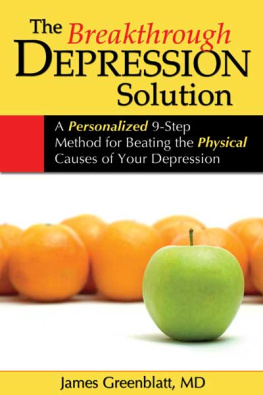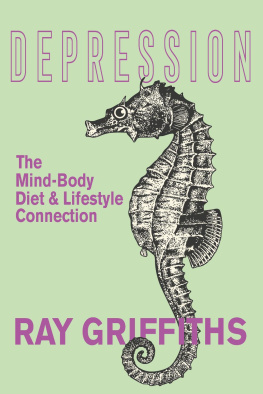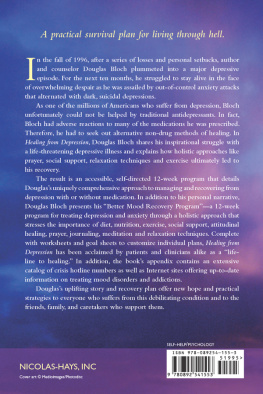


CONTENTS

PROLOGUE
If you are struggling with feelings of depression now or have experienced bouts of depression in the past, I'm very glad that you've found this book. The Mind-Body Mood Solution offers a powerful set of tools that can help you lift your mood and positively transform your life.
While you may experience significant improvements right away, the techniques I will share in the coming pages do not offer a quick fix, nor are they a magic pill. You will need to make lifestyle changes and practice skills that will increase your self-awareness, get your energy moving, and lift your mood. If you commit yourself to these processes, they will not only help you feel better now, they will also help you stay physically and emotionally healthy for years to come.
The techniques I offer in The Mind-Body Mood Solution are strategies I've found to be successful for hundreds of my patients over the past 20 years. I realize that it can be challenging to apply the principles and tools printed on a book page to your own life; I wish that we could sit together so that I could help you through this process in person. However, in this book you will find the same tools and practices I share with my clients. I will guide you through the process of lifting your mood and ask you many of the same questions I pose to them. Because each person is unique and no one experiences the symptoms of depression in the same way, you will be able to customize your program by using the resources that are most useful to you.
If you are experiencing significant depression now, I suggest you ask for support from someone you trust. This could be a friend, a family member, a therapist, or a coach. Turn to Chapter 14 for specific advice on finding a therapist when professional help is needed.
Although the prevalence of depression is growing dramatically, most cases go untreated. Only one in three individuals suffering from depression receives treatment. There is still a stigma that prevents many people from seeking help for mental health issues. My hope is that we can move beyond the barriers created by that stigma so that everyone who is suffering can be helped. The earlier depression is treated, the more effectively and rapidly recovery can be achieved.
Fortunately, we have developed very effective treatments over the past 2 decades. Several types of psychotherapy have proven to be particularly helpful in relieving depression. Physical approaches involving nutrition, exercise, and exposure to bright light have also demonstrated a powerful, positive effect on depression. I have found that combining interventions that address both the mind and the body helps my clients recover more rapidly and durably than utilizing any one approach in isolation. I have been fortunate over the past 18 years to work at Canyon Ranch, a health resort and integrative wellness center in the Berkshire Mountains of western Massachusetts. In this setting, my clients are able to utilize complementary approaches including exercise, breathing, meditation, and nutrition. Very often, these approaches yield rapid results.
How to Use the Book and the Program
As you read through the opening chapters of this book, give some thought to whether these treatment options feel right for you and how much time you think you'll be able to devote to them. Also, be sure to complete the Readiness Assessment on page 13 to learn how you can get the most out of the program.
As you embark on this program, you may find it helpful to review and assess your progress periodically. To get a baseline measure of how you're feeling now, you can complete the depression assessment test (CES-D) on page 21. I suggest you retake this assessment each week for the next 8 weeks. Benchmarking your progress as you follow the program will help you evaluate its effectiveness.
The program offers several tools that you can use on a daily basis to enhance your mood. Some of these may be more helpful to you than others. Try them out and see what works best for you. The Readiness Assessment quiz will help you determine which strategies may be most useful for you and which tools you're most inclined to use. For instance, if your low mood is heavily related to nutritional deficiencies or dietary sensitivities, you may find the nutritional component of the program to be very effective. If your unhappiness is more influenced by a negative thought pattern, the attitudinal component may be most helpful to you. Chances are you will find that a combination of treatments is most relevant and useful for you.
Transforming Energy
At the heart of the program is the understanding that when we are feeling depressed, our life energy is blocked and we have difficulty moving forward. Life energy is the energy that is present in all living things, including plants, animals, and human beings. It is the energy that powers all the systems of your body and gives you a feeling of vitality. Each component of this program is designed to help you unblock your energy so that it flows naturally.
The energy blockage in depression is evident in several ways. Physically, most depressed people experience fatigue and lethargy. It is often difficult to get moving and find the energy to accomplish what you need to do each day. Others experience agitation and restlessness, and find that the energy they do have is stuck in a negative, uncomfortable pattern.
Emotionally, depression blunts life energy. The heaviness of depression weighs down our emotional life with feelings of guilt, despair, fear, regret, and resentment. Some people simply feel numb. The absence of emotion robs them of any joy or pleasure in life. Their emotions and their energy are stuck in a constricted pattern, rather than flowing outward toward others in positive expressions of love, appreciation, and engagement.
Energy blockage is also evident in the impaired cognitive functioning experienced by many people with depression. Problems with attention and memory are very common. Depressed students have trouble concentrating on their studies, depressed workers have trouble completing tasks, and depressed parents have trouble engaging with their children. For many, the endless cycle of replaying ruminative thoughts keeps their energy stuck in a circuit that prevents constructive, creative thinking. Unwanted rumination also hijacks the mind at night and interferes with sleep patterns.
When our physical, emotional, and cognitive energy is stuck, we find it impossible to move forward. We withdraw from friends and family, and hold back from initiating new projects, travel, or any other enterprise that requires our full emotional and physical engagement. We sometimes use unhealthy methods of avoiding or numbing our feelings, such as overindulging in alcohol, food, television, or sleep. This avoidant behavior is at the heart of depression.
Using the Program
The Mind-Body Mood Solution is designed to work with your body and your mind simultaneously to unblock your energy and get it moving in a positive direction. Each component of the program addresses a vital source of energy. Here is a brief overview of the physical strategies you will find in this book to help you accomplish this goal.
Next page










 CONTENTS
CONTENTS